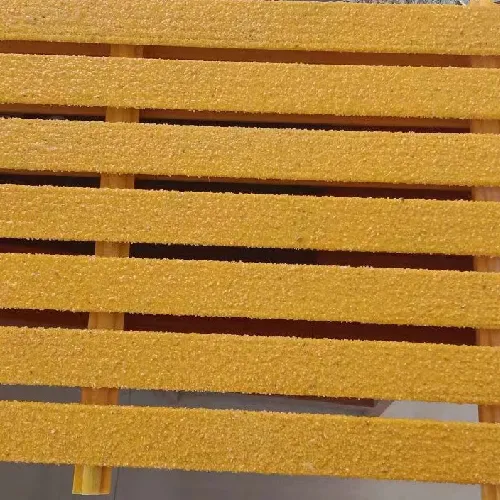loading...
- No. 9, Xingyuan South Street, Dongwaihuan Road, Zaoqiang County, Hengshui, Hebei, China
- admin@zjcomposites.com
- +86 15097380338
- Welcome to visit our website!
Exploring the Benefits of FRP Roof Decks for Modern Construction Practices
Understanding FRP Roof Decks Benefits and Applications
In the realm of construction and architecture, the materials employed significantly influence the performance, durability, and overall aesthetics of a structure. One such innovative building material that has gained popularity in recent years is Fiber Reinforced Polymer (FRP). Among its various applications, FRP roof decks are noteworthy for their exceptional properties and versatility. This article explores the benefits, characteristics, and common applications of FRP roof decks.
What is FRP?
Fiber Reinforced Polymer (FRP) is a composite material made from a polymer matrix reinforced with fibers, typically glass, carbon, or aramid. The integration of fibers enhances the strength, durability, and overall performance of the polymer, making FRP a robust choice for various applications. FRP is lightweight yet exceptionally strong, offering high resistance to corrosion and chemicals, making it ideal for environments where traditional materials might fail.
Benefits of FRP Roof Decks
1. Durability and Longevity One of the standout features of FRP materials is their impressive durability. FRP roof decks can withstand extreme weather conditions, including intense sunlight, rain, and freezing temperatures without deteriorating. Unlike traditional materials such as wood or metal that can warp, rust, or decay over time, FRP maintains its structural integrity, resulting in longer service life for structures.
2. Lightweight Construction The lightweight nature of FRP reduces the overall load on a building's framework. This is especially beneficial in large-scale constructions or areas with weight restrictions. The reduced weight can also lead to cost savings in structural support and foundation requirements, allowing for more efficient designs.
3. Resistance to Corrosion and Chemicals FRP is inherently resistant to a wide variety of chemicals, including acids and solvents. This makes it an ideal choice for industrial applications or roofs situated in corrosive environments. Its resistance to corrosion contributes to lower maintenance costs over its lifespan, as property owners are less likely to encounter issues that require repairs.
4. Design Flexibility FRP roof decks are highly versatile in design. They can be molded into various shapes and sizes, allowing architects and engineers to work creatively without being restricted by material limitations. This flexibility is particularly beneficial in modern architectural designs that often require unique shapes and aesthetics.
5. Thermal Insulation Many FRP products come with inherent thermal insulation properties, which can contribute to energy efficiency in buildings. By reducing heat transfer, FRP roof decks can help maintain a stable indoor temperature, potentially decreasing heating and cooling costs over time.
frp roof deck

6. Quick Installation Due to their lightweight nature and ease of handling, FRP roof decks can often be installed more quickly than traditional roofing materials. Faster installation reduces labor costs and project timelines, making it a practical choice for contractors.
Common Applications
FRP roof decks are utilized in a variety of structures, including
- Industrial Facilities Many factories and warehouses use FRP roof decks to take advantage of their durability and resistance to chemicals.
- Commercial Buildings Retail spaces and offices benefit from the lightweight and aesthetic qualities of FRP, enabling more innovative design concepts.
- Recreational Facilities Swimming pools, sports complexes, and amusement parks utilize FRP for its waterproof and corrosion-resistant properties.
- Bridges and Walkways The structural strength and lightweight characteristics of FRP make it ideal for pedestrian bridges and walkways where minimizing weight is critical.
Conclusion
The adoption of Fiber Reinforced Polymer roof decks marks a significant advancement in building materials technology. With their numerous advantages—ranging from durability and lightweight construction to resistance to corrosion and thermal insulation—FRP roof decks are poised to play an increasingly important role in modern construction. As more architects and builders recognize the benefits of this innovative material, we can expect to see its wider application across various sectors, contributing to more resilient, efficient, and aesthetically appealing structures. Embracing FRP technology not only aligns with contemporary design trends but also emphasizes the industry's commitment to sustainable and durable building practices.
-
The Rise of FRP Profiles: Strong, Lightweight, and Built to LastNewsJul.14,2025
-
SMC Panel Tanks: A Modern Water Storage Solution for All EnvironmentsNewsJul.14,2025
-
GRP Grating: A Modern Solution for Safe and Durable Access SystemsNewsJul.14,2025
-
Galvanized Steel Water Tanks: Durable, Reliable, and Ready for UseNewsJul.14,2025
-
FRP Mini Mesh Grating: The Safer, Smarter Flooring SolutionNewsJul.14,2025
-
Exploring FRP Vessels: Durable Solutions for Modern Fluid HandlingNewsJul.14,2025
-
GRP Structures: The Future of Lightweight, High-Performance EngineeringNewsJun.20,2025
